Hi folks! The UOM editorial board asked me to write a post about faculty salaries and the faculty union’s proposal for the readers of this blog and I am happy to do so. For those who want to listen/watch instead of read, I re-recorded the presentation I made to the Admin bargaining team (the live presentation was not recorded) which you can watch on YouTube.
If you who don’t know who I am: I’m a recently-tenured member of the Economics department at Oregon and my work is focused on imperfect competition in various marketplaces. I’ve had an interest in university governance dating back to graduate school – I was heavily involved in the graduate student government as a Ph.D. student at Minnesota, and I’ve dipped my toes into university service (via the Senate Budget Committee) and now, I suppose, university politics. Perhaps most notably for readers of this blog, I was one of the people working (mostly) behind-the-scenes on the “Progressive Pay Reduction” package negotiations during the height of the COVID-19 crisis.
I even got a paper out of that one.
Given that experience, I was asked by the union last fall to help them craft a salary proposal for the current round of bargaining. I worked with several others to hammer out the details and I presented it at the table last week.
My interest in faculty salaries is not purely self-motivated. I’m doing fine (though my department is one of the lowest paid on campus relative to our comparators). To put it in the words of my generation, what I’m worried about are the vibes.
No, seriously, hear me out.
The vibes here aren’t great. I’ve worked in a variety of environments on my path toward a faculty role here: public sector, private sector, academic support. But I’ve never worked at an organization with a more strained relationship between leadership and those at the front line of the mission (and I worked in financial services during the Great Recession). We can see it in the IDEAL Climate Survey results, where we learned that faculty at UO are far unhappier than faculty at other higher education institutions.
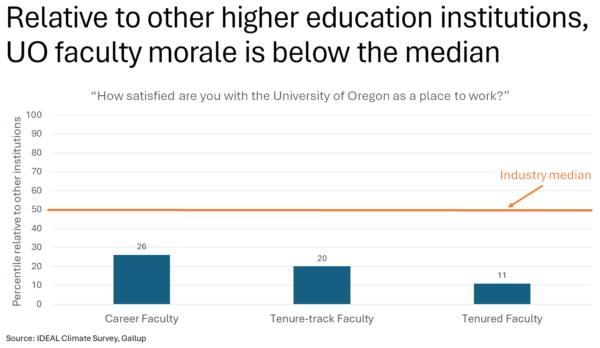
We’re also seeing it in faculty departures and in the increasing difficulty we are experiencing hiring faculty: 25% of the searches for tenure-related faculty that we started in 2022-2023 failed, relative to an average rate of around 15% pre-COVID.
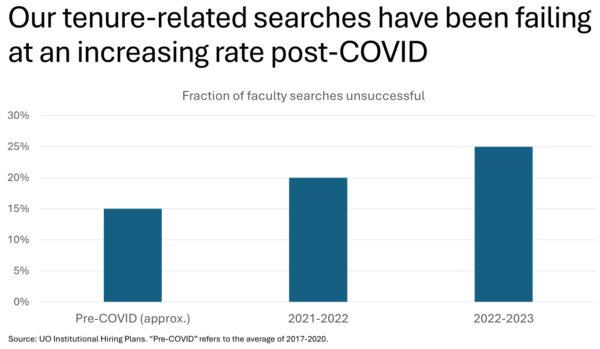
We face many challenges on the way to creating a better place to work (and better vibes), but we can’t ignore our low salaries. How low? Well, according to the 2022-2023 Faculty Compensation Survey conducted by the American Association of University Professors, Oregon is at the very bottom of the Big 10 conference. Our salaries are (on average) lower than salaries in Nebraska, Iowa, and Indiana.
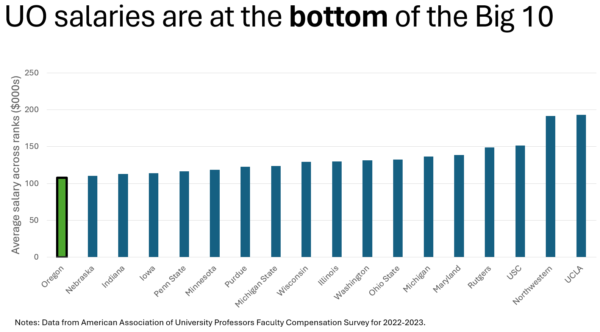
Now, the Big 10 is an athletic conference first and has relatively little to do with academics. The UA proposal aims to bring average salaries for our academic employees (faculty, researchers, librarians, and others) up to the average for our academic peers: the public universities within the Association of American Universities (AAU). Today, UA projects that faculty at UO take home about 84% of the pay of their peers at the AAU-Publics . For comparison, UO’s President earns a base salary that is very close to the average base salary for AAU-Public campus leaders.
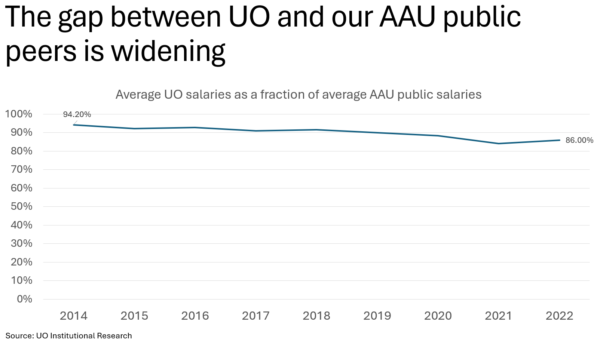
UA’s proposal brings that up to 100% over the three years of the contract by creating raise pools of 9.4% in each of the contract years. In the first year, the proposal dedicates the entire pool to an across-the-board raise for all bargaining unit employees. In the second year, there is a more modest 4.4% across-the-board raise, with the remaining 5% allocated to both internal equity issues (compression, inversion, etc.) and external equity issues (competitiveness at the unit-rank level). In the third year, 6% of the pool is allocated to merit pay, with the remaining 3.4% allocated to an across-the-board raise.
We estimate that this proposal will result in an increase in costs of $57.6 million by the end of the contract (specifically, the cost of faculty in FY 2024 is approximately $186.2 million, and we project the cost of faculty in FY 2027 to be $243.7 million). But the dollar amount isn’t the most important thing (though it is important). What matters is whether the University can afford it.
We think it can. Let’s take as given the accounting constraints that faculty salaries come from the “Education and General Fund” (or “E&G bucket”). Historically, UO has spent over 30% of that fund on compensation for Tenure-Related and Career faculty (including benefits). In the last couple of years, thanks to growth in undergraduate enrollment and small raises, that fraction has dropped to around 27%. Assuming the E&G fund experiences only average growth over the next couple of years (i.e. no major increases in tuition, no major increases in state support), the UA proposal would increase that fraction to 34%.
Notably, this proposal would also bring our spending more in line with our peers across the AAU-Publics. According to data collected by the federal government, our peers spend roughly 33% of their “core revenues” (i.e. revenues not from auxiliary units or hospitals) on salaries for instruction, research, and public service. UO spends about 23%.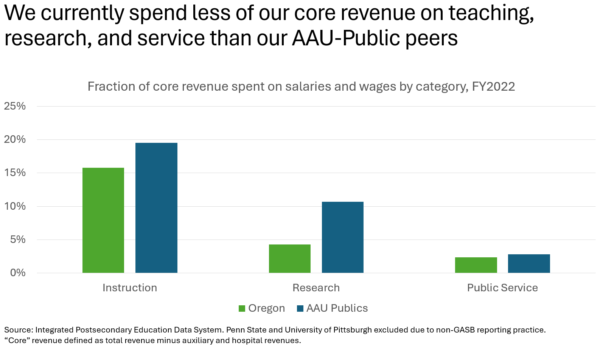
To sum up: faculty at UO (through their union) are asking to be paid the average of their peers. Getting there requires raises of less than 10% per year over the next three years. That might sound big, but it won’t break the bank.
Excellent write up! As a non faculty member, this context is exceptionally helpful.
Thanks for this reality check. I knew salaries were bad, but this is ridiculous. Is there any evidence the new President thinks this is a problem?
Loved this presentation. I was left wondering if the salary comparisons was apples to apples (maybe we are just at the bottom of the Big 10 pay scale because we don’t have a med school). Then I discovered that Nebraska and Indiana do have med schools!
It’s apples to apples – adjusts for diffs in the composition of fields and in rank by field.